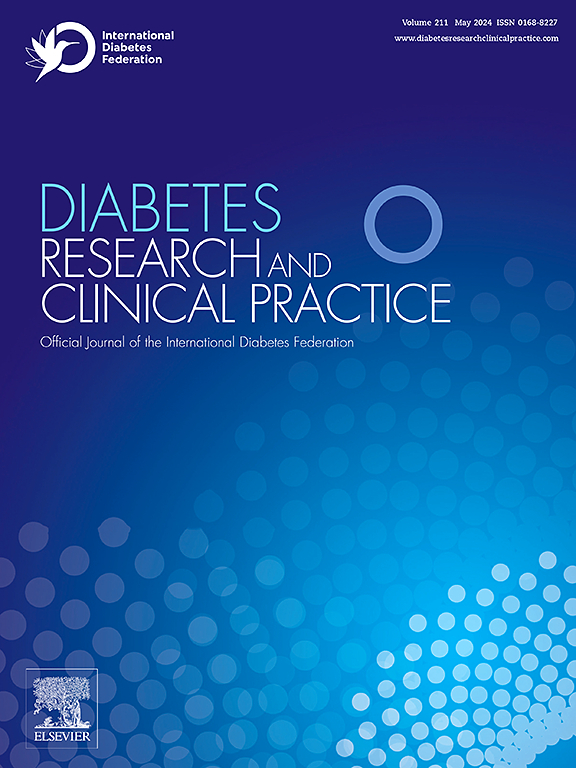Genome-wide Mendelian randomization study identifies therapeutic targets for diabetic microangiopathy
IF 6.1
3区 医学
Q1 ENDOCRINOLOGY & METABOLISM
引用次数: 0
Abstract
Aims
This study aims to identify potential therapeutic targets for diabetic microangiopathy by integrating genome-wide association studies (GWAS) and Mendelian randomization (MR) analyses.
Methods
A comprehensive analysis of GWAS datasets on diabetic microangiopathy was conducted by using two-sample MR to determine the causal effects of blood-expressed druggable genes at both the transcriptional and protein levels. Co-localization analysis was conducted to validate gene-trait associations, while phenome-wide association studies (PheWAS) explored broader phenotypic implications. Additionally, protein–protein interaction (PPI) networks were constructed to elucidate gene interactions and molecular docking was conducted to determine therapeutic druggability.
Results
Nine candidate therapeutic targets (PSORS1C3, HLA-C, RAMP1, CTSG, SREBF1, BTN3A2, PPA1, PRKD2, and PPIG) were identified, with co-localization analysis confirming their involvement in diabetic microangiopathy. Among them, HLA-C exhibited associations with additional traits, suggesting the specificity of the remaining targets. Functional enrichment analysis indicated a predominant involvement of immune-related pathways, underscoring their relevance to the pathogenesis of diabetic microangiopathy. Furthermore, molecular docking studies revealed strong binding affinities.
Conclusions
This study provides compelling genetic evidence supporting the role of immune-related druggable genes in diabetic microangiopathy and identifies novel therapeutic targets for intervention.
全基因组孟德尔随机化研究确定糖尿病微血管病变的治疗靶点。
目的:本研究旨在通过整合全基因组关联研究(GWAS)和孟德尔随机化(MR)分析,确定糖尿病微血管病变的潜在治疗靶点。方法:采用双样本MR对糖尿病微血管病变的GWAS数据集进行综合分析,从转录水平和蛋白水平确定血液表达的可用药基因的因果关系。共定位分析用于验证基因-性状关联,而全表型关联研究(PheWAS)则探索更广泛的表型含义。此外,构建蛋白-蛋白相互作用(PPI)网络来阐明基因相互作用,并进行分子对接以确定治疗性。结果:9个候选治疗靶点(PSORS1C3、HLA-C、RAMP1、CTSG、SREBF1、BTN3A2、PPA1、PRKD2和PPIG)被确定,共定位分析证实它们与糖尿病微血管病变有关。其中,HLA-C与其他性状相关,提示剩余靶点的特异性。功能富集分析表明主要参与免疫相关途径,强调其与糖尿病微血管病变发病机制的相关性。此外,分子对接研究显示了很强的结合亲和力。结论:本研究提供了令人信服的遗传学证据,支持免疫相关药物基因在糖尿病微血管病变中的作用,并确定了新的干预治疗靶点。
本文章由计算机程序翻译,如有差异,请以英文原文为准。
求助全文
约1分钟内获得全文
求助全文
来源期刊

Diabetes research and clinical practice
医学-内分泌学与代谢
CiteScore
10.30
自引率
3.90%
发文量
862
审稿时长
32 days
期刊介绍:
Diabetes Research and Clinical Practice is an international journal for health-care providers and clinically oriented researchers that publishes high-quality original research articles and expert reviews in diabetes and related areas. The role of the journal is to provide a venue for dissemination of knowledge and discussion of topics related to diabetes clinical research and patient care. Topics of focus include translational science, genetics, immunology, nutrition, psychosocial research, epidemiology, prevention, socio-economic research, complications, new treatments, technologies and therapy.
 求助内容:
求助内容: 应助结果提醒方式:
应助结果提醒方式:


